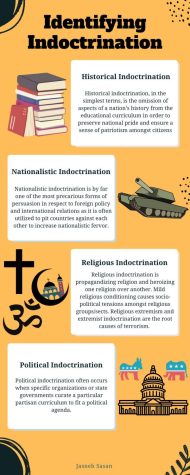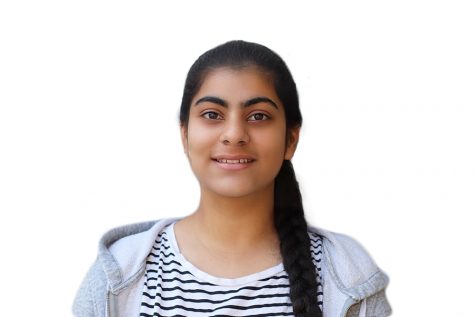Trigger Warning: This article mentions death, violence, terrorism, torture, and indoctrination of minors and contains emotionally disturbing and shocking imagery. Specific examples mentioned in this article are not intended to attack specific nationalities, races, ethnicities, or religions. All examples are meant for educational purposes.

Despite an age of rapid globalization and collaboration, the world is infested with hostility and contempt. World leaders struggle to find solutions to a perilous global divide as they scramble to address surface issues without bothering to consider the impacts of the fundamental reason for such segregation: educational indoctrination.
The Merriam-Webster’s dictionary defines the word “indoctrination” as teaching someone to “fully accept the ideas, opinions, and beliefs of a particular group and to not consider other ideas, opinions, and beliefs.”
Indoctrination is, in the most literal sense, brainwashing students into believing certain ideologies that fit a certain standard and adhering to government-controlled propaganda. Simply put, indoctrination feeds students misinformation and prohibits them from so much as learning about different perspectives, let alone allowing them to voice their opinions.
In this sense, there is little to no contrast between today’s education system and political prison. Yet, the disgusting impacts of propagandized education are often swept under the rug. It is undeniable that educational indoctrination and political conditioning of younger generations is the sole reason for global partition between nations, religions, ethnicities, etc.
Typically, indoctrination has been divided into four prominent categories along a broad continuum: historical, nationalistic, religious, and political. The categories share commonalities and intersections, yet are each distinctly dangerous. Developing an understanding of the varying forms of educational conditioning is vital to identify and curb their disastrous impacts.
Historical Indoctrination
Historical indoctrination, in the simplest terms, is the omission of aspects of a nation’s history from the educational curriculum in order to preserve national pride and ensure a sense of patriotism amongst citizens.
While historical indoctrination is one of the most common types of political conditioning, the most popular example is Japan’s strategic omission of the extent of its pronounced, horrific war crimes in China and the Koreas during World War II.
“Under imperial Japan, Korea experienced some truly horrendous things. Many Koreans were lured to work camps where they were placed under life-threatening conditions on the daily and were rarely paid. They were crowded into underwater mining tunnels where poisonous gas and seawater leaked, many collapsing and taking the workers with them,” said Yebom Yang, a Junior at Prosper High School who immigrated from South Korea. “Those tested were kidnapped from their homes, called ‘maruta’ or ‘wooden log’ in Japanese. They were tested brutally. Some stood without clothes outside in freezing temperatures until their bodies froze. They would then be splashed with ice-cold or boiling-hot water to see the best way to defrost a body. Many of these facts are unrecognized, understated, and put away by the Japanese government today.”
Yang, having lived in a nation that was greatly impacted by Japan’s horrendous war crimes, is passionate about spreading awareness about Japanese indoctrination in schools today.
The Japanese war crimes have been recognized by various political and historical organizations, such as the World War II Memorial, the U.S. Department of Justice, and more.
The Japanese curriculum conveniently avoids covering the subject of well over 10 million reported deaths as a result of Japanese war crimes during World War II. Japan’s inability to adequately address its past atrocities has severely impacted international relations in East and South-East Asia, furthering deep social divides amongst the Asian community across the globe. By refusing to air out old wounds, divisions amongst East Asian nations have accelerated global tensions, threatened warfare, and opened the possibility of global nuclear conflict.
It is clear that the effects of the way schools teach their history curriculum extend outside the classroom. Japan is just one of several countries, including the United States, that utilize the strategic exclusion of historical events to further a patriotic cause. The impact of this method of educational conditioning is profound – from brainwashing students into ignoring the deaths of tens of millions of innocent civilians to being one of the largest root causes for political tensions amongst three of the most powerful regions in the world, historical indoctrination isn’t only unethical, it is detrimental to foreign alliance and global peace.
Nationalistic Indoctrination
Nationalistic indoctrination is by far one of the most precarious forms of persuasion with respect to foreign policy and international relations as it is often utilized to pit countries against each other to increase nationalistic fervor. The most common identification of nationalistic conditioning is the obvious villainization of a certain nation or group of nations and the consequent romanticization and heroization of one’s own nation and national affiliation.
A popular example of nationalistic indoctrination is the tensions in South Asia, primarily between India and Pakistan, as a result of the Indian Partition of 1947. According to TRT World, a popular Turkish international news publication, both the Indian and Pakistani history curricula, respectively, villainize the other’s national heroes.
The brainwashing doesn’t stop there. Students, as young as kindergarteners, are encouraged to join the armed forces, not for the protection of their own country, but for the destruction of the other. Those who take up careers in S.T.E.M. fields are expected to champion scientific progress such as nuclear and atomic advancement, not for the celebration of scientific achievement, but to aid the government in defeating its neighbor.
In a now viral video, Pakistani student(s) announced their career goals at a school function. This unnamed student expressed his vision to join the army so he could “save Pakistan and destroy India.” He was applauded by his teachers and peers.
Two nations, so similar in culture, language, and ethnicity are divided by a ragged line and spite. Those who would appear to be brothers in the eyes of the world are pitted against each other because their governments cannot determine how to appropriately draw the lines of the Kashmir border.
The Global Conflict Tracker has detailed a list of major conflicts between India and Pakistan in the past decade which has led to the deaths of tens of thousands of soldiers and civilians and the displacement of an innumerable number of citizens from both nations. To make matters worse, the conflict between the two countries, both of which are nuclear powers, has stemmed into a larger issue: nuclear war. Dubbed “IndoPak,” it is one of the most unstable nuclear conflicts waiting to erupt. Both nations have extraordinary international support: China is an ally of Pakistan, hence the U.S. is a stable ally of India. IndoPak could easily become a proxy war between the United States and China– possibly creating a destructive World War III which would ensure the obliteration of the South Asian subcontinent, leaving Indians and Pakistanis alike as collateral damage for a bigger global conflict.
Religious Indoctrination
Religious indoctrination is, by far, the easiest to identify, of the four primary types of indoctrination, but it is also the most complex as it creates its own spectrum of extremity. Religious indoctrination, put simply, is propagandizing religion and heroizing one religion over another. Mild religious conditioning can cause socio-political tensions amongst religious groups or sects. However, religious extremism and extremist indoctrination are the root causes of terrorism.

Religious extremism is most prevalent in South Asia and the Middle East*, specifically within Jihadist groups in Iraq, Syria, and the general caliphate, commonly known as I.S.I.S. or al-Qaeda. In his research paper, “I.S.I.S. Child Soldiers in Syria: The Structural and Predatory Recruitment, Enlistment, Pre-Training Indoctrination, Training, and Deployment” by Dr. Asaad Almohammad, a Senior Researcher with the Program on Extremism at George Washington University and a prominent member of the Foreign Policy Research Institute, researched the methods of indoctrination used to coerce children, specifically under the age of 15, into serving terrorist groups like al-Qaeda.
In the paper, Almohammad details specific transcripts of I.S.I.S. recruiters urging child soldiers to join their fold. “‘I [wanted/loved] to give you some advice for the sake of god, glory to him, the exalted … It is that you are in Turkey, in the land of tyrants. You leave the land of tyrants and you come back to the land of Islam…I swear to god Haji, I don’t know what to tell you! Don’t think about your parents and your father and mother, appease your god. Appease your god Haji! If you appease your god, you will see what you’ll get. Everything! Money, dimes, whatever you desire. Women, power! Nothing would stop you Haji.’”
Terrorist groups like al-Qaeda use isolationist practices, subject their child soldiers to continuous violence, and brainwash minors into believing that if they sacrifice their life for the Jihadist cause, they would appease God and thus be liberated.
“The two books that are intensely taught at [Jihadist] schools are Learn the Order of Your Religion and the Book of Monotheism and Doctrine. Through the first book, children are taught the meaning of ‘no god but allah’, al-Wala (loyalty) and al-Bara (disavowal). Furthermore, they’re taught the Takfir– the belief that anyone who isn’t a Muslim is impure and tyrannical,” Almohammad said.
According to Statista, there were close to 30 thousand reported deaths due to terrorist attacks in 2020 alone. Since 2006, there have been over 306,000 fatalities as a result of terrorist attacks worldwide. Religious indoctrination, like the extremist conditioning practiced by terrorist groups, has taken the lives of hundreds of thousands of innocent civilians and started various global conflicts– including America’s war on terrorism. In both cases, civilians have been collateral damage.
Political Indoctrination
Political indoctrination is the most common form of indoctrination in the United States, as it is a result of partisan divisions. This type of conditioning often occurs when specific organizations or state governments curate a particular partisan curriculum to fit a political agenda.
Political indoctrination is one of the most prominent reasons why the United States suffers from political divisions far more than European nations like France and Britain. The United States doesn’t have a national curriculum, which often leaves educational control up to state governments and local departments.
The decentralization of the history curriculum is a significant cause for America’s very prominent conservative and progressive state divisions. Because the state-controlled curriculum doesn’t address a broad scope of political views, students are pigeonholed into believing the prominent political ideology in their community.
Political indoctrination doesn’t allow students to analyze political structures, instead, it feeds students partisan viewpoints. Hence, schools are no longer teaching students how to think, but instead persuading them on what to think.
Instead of being taught to properly analyze and understand the nuances of political conflicts, students are taught that there is one right answer. Banning guns versus gun access for all. Banning abortion versus unrestricted abortion access. Democrat versus Republican. History and civics classes continuously treat political solutions like all-or-nothing decisions, hence, they villainize other ideologies.
What now?
The impacts of indoctrination are clear: destruction, hostility, and division. While there is no clear solution to the problem of indoctrination, it is evident that the way history is taught to students impacts every aspect of internal and global politics. Thus, it is vital to identify aspects of indoctrination in our curriculum and work to objectively present historical events.
This generation has the opportunity to break free from the shackles of generations of brainwashing and indoctrination, to air out old wounds, reach mutual understanding, and become more open to different ideologies.
The education system was designed to create followers– slaves of a system that works against the people it’s meant to protect– yet, by understanding the extent of control that the education system exerts over pupils can help them strive to become thinkers, analysts, leaders, and more.
As the revolutionary primologist and anthropologist, Jane Goodall once said, “The greatest danger to our future is apathy.” All the forms of indoctrination systemically exploit students’ naivety and apathy. Therefore, the first step is to get informed, then to inform others. By doing so, the education system can be reformed to finally nurture future leaders instead of grooming tomorrow’s laborers.
* The Middle East is one of many regions that utilizes religious indoctrination. Jihadism is not a tenant of Islam, nor is it accepted by the grand majority of the global Muslim population. Islam doesn’t teach violence, terrorism, or extremism. This article specifically mentions Jihadist terrorist groups, not the Islamic community as a whole.




